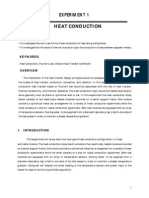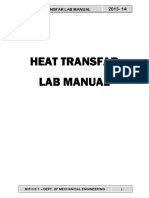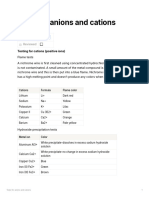Thermal Conductivity of Insulating Material
Thermal Conductivity of Insulating Material
Uploaded by
manojkumar667788990077Copyright:
Available Formats
Thermal Conductivity of Insulating Material
Thermal Conductivity of Insulating Material
Uploaded by
manojkumar667788990077Copyright
Available Formats
Share this document
Did you find this document useful?
Is this content inappropriate?
Copyright:
Available Formats
Thermal Conductivity of Insulating Material
Thermal Conductivity of Insulating Material
Uploaded by
manojkumar667788990077Copyright:
Available Formats
THERMAL CONDUCTIVITY OF SOLIDSINSULATTNG
SAB
AÍM:
Insala
lo determine the thermal conductivity of a eonducting materíal, say asbestos
sheet by guarded hot plate method.
THEORY:
is
Thermal conductivity is a specific property of any conducting material which
defined below for a homogencous solid as the quantity of heat conducted across a unit
the
area normal to the direction on unit time and for unit temperature gradient along
flow.
qdL
K=
A dT
Where
q =heat conducted in watts
dL =length (m)
A =area of conduction heat transfer, m²
dT =temperature difference across the length dL (deg. C)
BASIS OF MEASUREMENT:
can be accomplished
Experimental measurement of thermal conductivity of solid
of the temperature gradient across a
by a variety of methods, all based on the observation has
area of the material conducting heat at a known rate. Each of these methods
given
another is governed by the general
certain unique limitations, and the choice of one over
physical structure of the material in
temperature level at which 'K is measured by
poor conductor.
question, and by whether the material is a good or
In measuring the thermal conductivity of poor conductors, the specimens are
and the conducting
taken in the form of sheets in order that the heat flow path be short
area large (low dL, higher A).
experiment.
Guarded-hot plate method is generally used to conduct such an
heated thermal guards are
Figure 1 illustrates this method. In this method, electrically
Themal Conductiity Of Solids
placed adjacent to the exposed surface of the source H, specimen S, and sink Ho, These
thermal guard plate are independently maintained at the same temperature as the
Adjacent surface, to ensure ideally no heat leakage occurring from source, specimen or
the sink boundaries. The enclose drawings given actual dimensions of various
componeDts of the apparatus.
DESCRIPTION OF APPARATUS
Enclosed drawing and various specifications associated with all the components.
assembly
The test specifications associated with all the components. The test section
are shown
consisting of the asbestos specimen, heaters as well as thermocouples
the two
separately 9 thermocouples are available to measure temperatures of heaters,
(T3-T) gives the
specimens and the water inlet and outlet. I should be noted that
corresponding
temperature gradient across the top asbestos sheet and (Ts-T%) gives the
the cooling water
Quantity for the bottom specimen. Provision is also made to measure
mineral wool to
flow rate. The whole assembly is enclosed in an insulating layer of
possible.
prevent radiation and connective losses to the maximum extent
EXPERIMENTAL PROCEDURE
'H (the main heater MH). Now
Supply a small quantity of energy to the source
temperatures are same as that of the
adjust the input to the guard heaters such that the
circuit slowly. Allow 20-30minutes for the
main heater. Allow water through the cooling
temperatures, V, I, the water flow rate
temperatures to stabilize, note down all the
temperature values by adjusting
(cm/min). Repeat the experiment at different at
appropriately the input conditions.
SPECIFICATIONS:
Material; Asbestos sheet (commercial grade)
Specimen dia, d = 150 mm or 0.15m
one at the top and one at the bottom)
Specimen thickness,AL -2x12mm (2 pieces,
Area of specimen= --- (0.15)² m²=0.018 m?
4
Heat input Hi =0.86 VI watts
Main heater and guard heater.
Heat input is from two contributions:
obtain the total heat that is dissipated by
Both these contributions are to be summed up to
input will pass (ideally through each of the
the heaters. However only half of this heat
Tlhermal Conductivty of Solids
sandwiched between 2
wO Specimens) It may also be noted that since the heaters are
layers of commercial grade asbestos sheet, heat will be dissipated through both the layers.
Forthe purpose of calculations, average temperature gradient
[(Ts-Ta)+ (Ts-T) ]+2 is used.
OPERATIONAL PROCEDURE:
indicator (all digital), dimmer
The panel consists of voltmeter, ammeter, temperature
controls, thermocouples selector switch and schematic diagram.
5amps power supply socket, dimmers in
a) Connect the three pin top to 230v, 50 Hz,
OFF position.
in lposition. Turn the dimmer one
b) Keep thevoltmeter and ammeter selector switch
heater to any desired value by
in clockwise and adjust the power input to main
looking at the voltmeter and ammeter
20-30 minutes.)
c) Allow the unit to stabilize (anywhere from
temperature indicator by turning
d) Note down the temperature indicated by the digital 7,8,9)
the thermocouples selector switch clockwise step by step (1,2,3,4,5,6,
heater.
e) Repeat the experiment for different power inputs to the
conditions.
f) Tabulate all the readings and calculate for different
knobs anti clockwise direction,
g) After the experiment is over turn all the dimmer
bring back the voltmeter, ammeter and thermocouple selector
Switches to their original position, disconnect the three pin plug top from top the
mains.
CAUTION:The equipment should be operated betweeh 60 and 100 V.
Tlhermal Conductivity Of Solids
MODEL CALCUATIONS:
Insulating material :Asbestos (commercial grade)
Specimen dia :150mm =0.15 m
II
Area of specimen ---- (0.15) = 0.018m?
4
Specimen thickness : AL-12mm =0.012m
SAMPLE READINGS
S V in Iin T1 T2 T3 T4 T5 T6 T7 T8 T9
No. Volts Amps
1 60 0.295 71 55 49 29 48 35 25 27 29
V=60 Volts
I =0.295 Amps
q=0.86 " 60° 0.295
- 15.22 W
AT = ((T3-Ti) +(Ts-T.)) +2
=(49 - 29) +(48 -35)) +2
- 16.5 Degt.
AL = 0.012 m
A=0.0176 m²
THERMAL CONDUCTIVITY OF SPECIMEN:
q AL 15.22 x 0.024
K
AAT 0.0176 x.289-5
16-s
0.0717 Y/m- K
Thernal Conductivity Of Solids
You might also like
- Exp 1 Heat ConductionDocument10 pagesExp 1 Heat ConductionHanun Tarmizi0% (1)
- Experiment #3: Fourier'S Law: The Effects of Varying Cross-Sectional AreaDocument5 pagesExperiment #3: Fourier'S Law: The Effects of Varying Cross-Sectional AreaNaeem AkramNo ratings yet
- Guarded Hot Plate NCDocument3 pagesGuarded Hot Plate NCAniket MongaNo ratings yet
- Thermal Engg. Practical PR 1 To PR 5 PDFDocument18 pagesThermal Engg. Practical PR 1 To PR 5 PDFJstar jstarNo ratings yet
- Linear N Radial Heat Conduction ApparDocument16 pagesLinear N Radial Heat Conduction ApparisdiantiNo ratings yet
- Heat Transfer Lab ManualDocument44 pagesHeat Transfer Lab ManualNaveen luckyNo ratings yet
- Thermal Conductivity Apparatus: (Two Slab Guarded Hot Plate Method)Document8 pagesThermal Conductivity Apparatus: (Two Slab Guarded Hot Plate Method)AdityaNo ratings yet
- HT Lab ManualDocument61 pagesHT Lab ManualAdeep ChowdaryNo ratings yet
- Amali 3 First LawDocument7 pagesAmali 3 First LawNur ShazzyNo ratings yet
- Heat TransferDocument10 pagesHeat TransferMichael AugustineNo ratings yet
- HT FINAL (1)_removedDocument75 pagesHT FINAL (1)_removedtejanagaraj29No ratings yet
- Experiment 1.thermal Conductivity of Metal Rod-3Document6 pagesExperiment 1.thermal Conductivity of Metal Rod-3Prem ThakurNo ratings yet
- Heat Transfer LabDocument32 pagesHeat Transfer LabSweetyNo ratings yet
- Microsoft Word - HT LAB MANUAL - Doc 2013-14 PDFDocument74 pagesMicrosoft Word - HT LAB MANUAL - Doc 2013-14 PDFbhulakshmideviNo ratings yet
- ME 2306 Thermal Engineering Lab - I Lab ManualDocument43 pagesME 2306 Thermal Engineering Lab - I Lab ManualShane HarrisNo ratings yet
- Thermal Conductivity Guarded Plate ApparatusDocument4 pagesThermal Conductivity Guarded Plate Apparatusvis3012100% (1)
- Heat Transfer LabDocument17 pagesHeat Transfer Labgauravojha1000No ratings yet
- Composite Wall ExperimentDocument6 pagesComposite Wall ExperimentVillanNo ratings yet
- Exp 13Document5 pagesExp 13Dhanush kumarNo ratings yet
- H. Bunyan and Sorgo: Michael Miksa Chomerics Division of Parker Hannifin Corp. 77 Dragon Court, Wobum, MADocument4 pagesH. Bunyan and Sorgo: Michael Miksa Chomerics Division of Parker Hannifin Corp. 77 Dragon Court, Wobum, MAPrajwal GhadekarNo ratings yet
- Lab ManualDocument57 pagesLab ManualFawziyyah AgboolaNo ratings yet
- Thermal Conductivity of Solids PDFDocument8 pagesThermal Conductivity of Solids PDFIlandjezianNo ratings yet
- TE19 Thermal Conductivity ExperimentDocument11 pagesTE19 Thermal Conductivity ExperimentbassamNo ratings yet
- Thermal Conductivity Meter: Guarded Heat Flow Test MethodDocument2 pagesThermal Conductivity Meter: Guarded Heat Flow Test Methodrajesh_rbpNo ratings yet
- Control of The Uniformity of Direct Electrical Heating For Rotational MouldingDocument4 pagesControl of The Uniformity of Direct Electrical Heating For Rotational MouldingWajidNo ratings yet
- DGC 30033 - Lab Heat Transfer by ConductionDocument5 pagesDGC 30033 - Lab Heat Transfer by ConductionRaveena NaiduNo ratings yet
- HMT (ME-701)Document19 pagesHMT (ME-701)shuklavanishNo ratings yet
- 1 s2.0 0017931087900457 Main PDFDocument10 pages1 s2.0 0017931087900457 Main PDFSri VatsanNo ratings yet
- Thermal Engineering Lab 2Document29 pagesThermal Engineering Lab 2Haris P.A.No ratings yet
- Thermal Lab ReportDocument43 pagesThermal Lab ReportMainakendra Nath MandalNo ratings yet
- Composite WallDocument7 pagesComposite WallDhananjay KadamNo ratings yet
- Experiment of HTDocument41 pagesExperiment of HTRonak ModiNo ratings yet
- Experiment 6Document6 pagesExperiment 6Muhammad AsimNo ratings yet
- MPU-Heat-and-Mass-Transfer-Lab mannualDocument42 pagesMPU-Heat-and-Mass-Transfer-Lab mannualkajalrawatr247No ratings yet
- Experiment 1 LinearDocument6 pagesExperiment 1 LinearDeniseLimNo ratings yet
- MEC 595 Thermal and Design LabDocument53 pagesMEC 595 Thermal and Design Labraipardeep9600No ratings yet
- HMT Lab Mannual-ME - 605 FinalDocument21 pagesHMT Lab Mannual-ME - 605 FinalneinNo ratings yet
- E5-Conduction Heat TransferDocument15 pagesE5-Conduction Heat TransferYazid NazriNo ratings yet
- Composite WallDocument6 pagesComposite WallRushabh PatelNo ratings yet
- 11.guarded Plate ApparatusDocument4 pages11.guarded Plate ApparatusManoj Kumar.SNo ratings yet
- ME1324-Hmt Group 2Document14 pagesME1324-Hmt Group 2Arnab Dutta ChoudhuryNo ratings yet
- HMT Lab ManualDocument55 pagesHMT Lab ManualHarsha K100% (1)
- Experiment 14 - Heat Conduction Study BenchDocument11 pagesExperiment 14 - Heat Conduction Study Bencheven leeNo ratings yet
- Experiment No. 03 Aim: To Determine The Heat Transfer Coefficient in Natural ConvectionDocument6 pagesExperiment No. 03 Aim: To Determine The Heat Transfer Coefficient in Natural Convectionpriya3939No ratings yet
- Manual Heat Conduction 2Document4 pagesManual Heat Conduction 2aashuNo ratings yet
- 1 s2.0 001793109190056K MainDocument13 pages1 s2.0 001793109190056K MainAnitha Kumari SivathanuNo ratings yet
- Transient Plane Source (TPS) Technique For Measuring Thermal Transport. Properties Building MaterialsDocument7 pagesTransient Plane Source (TPS) Technique For Measuring Thermal Transport. Properties Building MaterialsGabs ChávezNo ratings yet
- H2 - Radial Heat ConductionDocument4 pagesH2 - Radial Heat Conductionmege1105No ratings yet
- Sir C.R.Reddy College of Engineering ELURU-534 007: Heat and Mass Transfer Lab ManualDocument43 pagesSir C.R.Reddy College of Engineering ELURU-534 007: Heat and Mass Transfer Lab ManualshamunuNo ratings yet
- Thermal Conductivity of Metal RodDocument6 pagesThermal Conductivity of Metal Rodanil chejara100% (7)
- Heat Transfer Lab Manual PDFDocument76 pagesHeat Transfer Lab Manual PDFMatam PrasadNo ratings yet
- HMT Lab Instruction ManualDocument6 pagesHMT Lab Instruction ManualAkash SharmaNo ratings yet
- Experiment - 5: AIM: Study and Calculate The Efficiency of Fin in Natural and Forced ConvectionDocument17 pagesExperiment - 5: AIM: Study and Calculate The Efficiency of Fin in Natural and Forced ConvectionRushabh PatelNo ratings yet
- Experiment 5 Thermal ConductivityDocument9 pagesExperiment 5 Thermal Conductivitybeasturs1No ratings yet
- EXP4Document4 pagesEXP4aqeel mohsinNo ratings yet
- NMR Analytical ChemistryDocument40 pagesNMR Analytical ChemistryTamara Chachi-Baía do SantiagoNo ratings yet
- 1 s2.0 S0038092X15001139 Main PDFDocument19 pages1 s2.0 S0038092X15001139 Main PDFMuhammad Bilal QadirNo ratings yet
- Unit 2 Mod 2 Back TitrationDocument1 pageUnit 2 Mod 2 Back TitrationFabio LayneNo ratings yet
- Tests For Anions and CationsDocument3 pagesTests For Anions and Cationscameron.yeung.08No ratings yet
- Gas Turbines For Aircraft Propulsion Chapter 9.9-10Document25 pagesGas Turbines For Aircraft Propulsion Chapter 9.9-10vipinNo ratings yet
- 4.2.4 Analytical Techniques QPDocument24 pages4.2.4 Analytical Techniques QPEman NoorNo ratings yet
- Process Engineering Manual 005 IDocument81 pagesProcess Engineering Manual 005 IzoeNo ratings yet
- Jan 2009 f321Document12 pagesJan 2009 f321fockoffuNo ratings yet
- Lecture 2.ENVIRONMENTAL FACTORSDocument14 pagesLecture 2.ENVIRONMENTAL FACTORSstar of skyNo ratings yet
- Jet Fuel Thermal Oxidation Test For Stability of Aviation Turbine Fuels (JFTOT)Document3 pagesJet Fuel Thermal Oxidation Test For Stability of Aviation Turbine Fuels (JFTOT)riyad aliNo ratings yet
- Antibacterial and Antioxidant Activity of Silver Nanoparticles Synthesized Using Aqueous Extract of Moringa Stenopetala LeavesDocument3 pagesAntibacterial and Antioxidant Activity of Silver Nanoparticles Synthesized Using Aqueous Extract of Moringa Stenopetala LeavesAfrah MNo ratings yet
- Guidelines For VOC Management Plan - Final - 2010Document31 pagesGuidelines For VOC Management Plan - Final - 2010Cari RiveraNo ratings yet
- Cambridge IGCSE: Co-Ordinated Sciences 0654/22Document16 pagesCambridge IGCSE: Co-Ordinated Sciences 0654/22Gina ChenNo ratings yet
- Physics Investigatory Project 2Document23 pagesPhysics Investigatory Project 2mallicksaad07No ratings yet
- Design & Simulation (Assign 4)Document11 pagesDesign & Simulation (Assign 4)Saad AhmedNo ratings yet
- Chapter 3Document49 pagesChapter 3Adnan QaseemNo ratings yet
- Aluminum + QuercetinDocument50 pagesAluminum + QuercetinAlenta JijiNo ratings yet
- Chapter 15 Cooling of Electronic Equipment Hkmuu RybtgnoDocument10 pagesChapter 15 Cooling of Electronic Equipment Hkmuu Rybtgnosmith jekysNo ratings yet
- Buffer Solutions in The BodyDocument3 pagesBuffer Solutions in The Bodynayyarshria06No ratings yet
- General Basic Catalysis PDFDocument7 pagesGeneral Basic Catalysis PDFOliiversito HrnandzNo ratings yet
- Guess Paper 9701-2 For 2024 MayDocument3 pagesGuess Paper 9701-2 For 2024 Maynida batoolNo ratings yet
- Chem Project PDFDocument9 pagesChem Project PDFimmortalmckingNo ratings yet
- Small Plane Grating Monochromator: Image Forming Properties of The Ebert MonochromatorDocument5 pagesSmall Plane Grating Monochromator: Image Forming Properties of The Ebert Monochromatordusan.papez9216No ratings yet
- Chem 315 - Extraction of CaffeineDocument18 pagesChem 315 - Extraction of CaffeinekNo ratings yet
- G11 Mole Concept RelDocument45 pagesG11 Mole Concept RelHIRTHIK LNo ratings yet
- A Basic Tutorial On Cyclic Voltammetry For The Investigation of Electroactive Microbial BiofilmsDocument10 pagesA Basic Tutorial On Cyclic Voltammetry For The Investigation of Electroactive Microbial BiofilmsSandraMeirellesNo ratings yet
- MTO AssignmentDocument15 pagesMTO AssignmentKshitij DalwadiNo ratings yet
- Solution StoichiometryDocument22 pagesSolution Stoichiometrygevekm garcenilaNo ratings yet
- Marcet Boiler Lab ReportDocument27 pagesMarcet Boiler Lab ReportamiraaikharahNo ratings yet
- Electrochemistry JEE Advanced Practice SheetDocument6 pagesElectrochemistry JEE Advanced Practice Sheetabhishekam192007No ratings yet

























































































